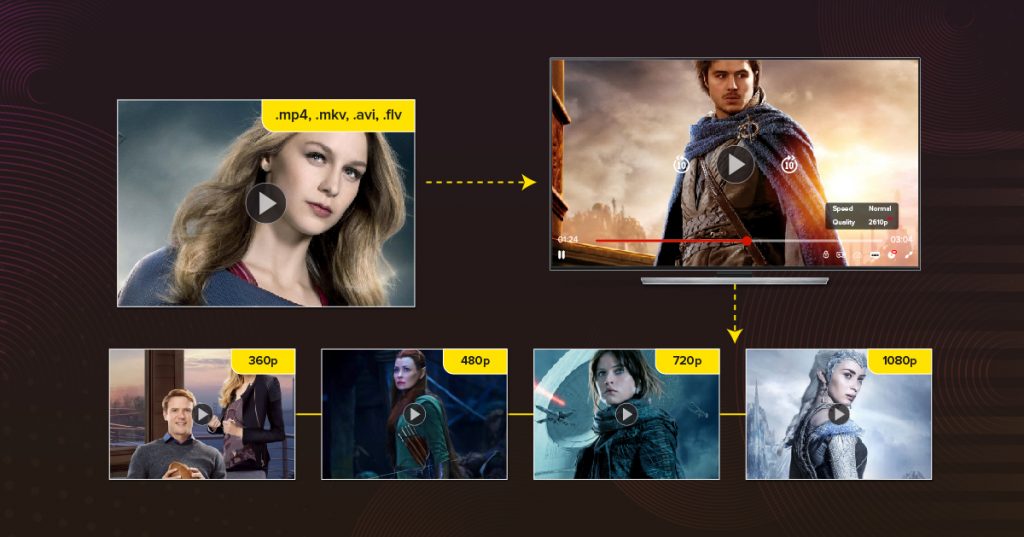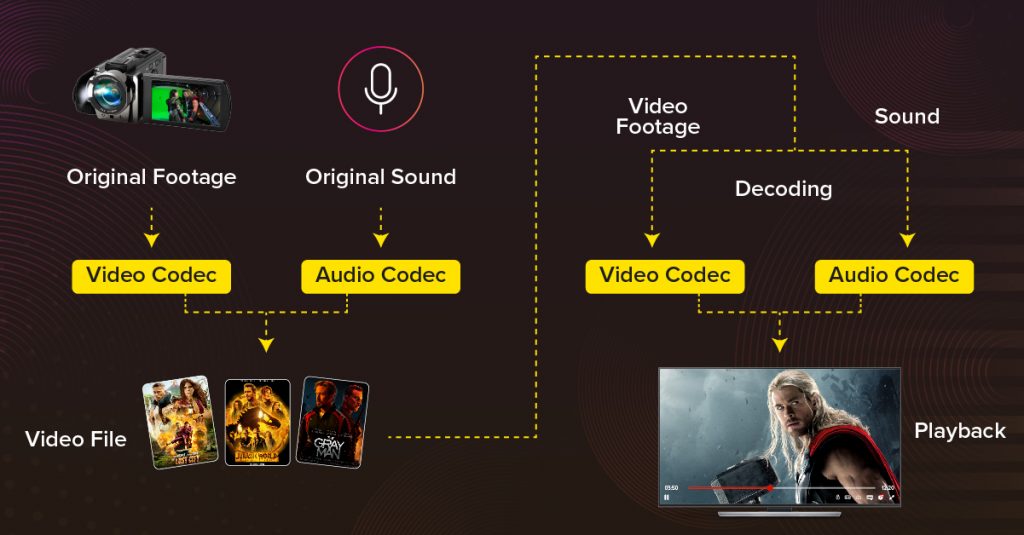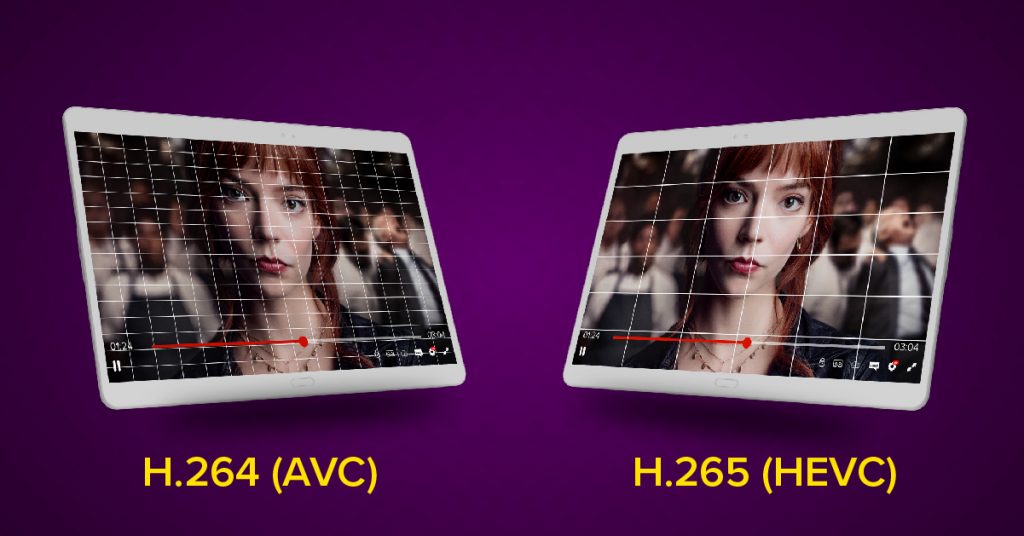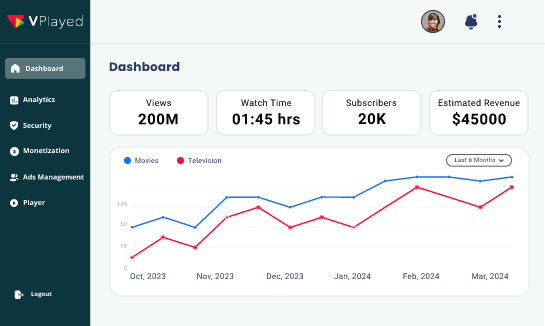Video Codec h264 vs h265: What It is & Which Is Better For Video Streaming?

It is worth noting, with the key principle of video quality overall which impacts regional preferences and consumption trends.
That’s why, Middle East has been observed with significant low avg. daily playtime than Europe or Pacific. They have a similar average buffer ratio.
*Another key metric for user engagement is the Avg. Bitrate. It is known that when the video quality gets higher, the rate of consumption equally increases.
Let’s compare the avg. bitrate levels for VOD with avg. number of daily titles per user & service. It is observed with how high quality levels result in consumers watching more episodes per day.*
Likewise users while watching an online video, movie or any sporting event, if there’s a disruption in the stream quality is compromised. In other words when the screen freezes up suddenly, then viewers may feel unsatisfied.
No matter, what they are watching, even if the quality isn’t there what was previously watched.. This abrupt loss of quality & might be extremely frustrating.
To combat this issue a recent technology has emerged and it is known as H.264 (AVC – advanced video coding).
It has been able to solve many quality issues that concern video broadcasting. In this guide, let’s learn what H.264 video encoding is, how it works along with its advantages, differences between H.264 vs H.265, etc in detail.
Let’s get started with..
Table of Contents
What Is H264 Or AVC Codec?

H.264 is commonly known as advanced video coding (AVC) or MPEG-4 part 10. It is the most widely used video compression standard in the industry right now.
The advanced video codec was first released in the year 2004 as a much more advanced version compared to its predecessors.
H.264 capacitates streams with a lower video bitrates by a much large margin with zero compromise in the quality of video nearly much as previous codecs.
This high efficiency video encoding is what precisely makes H.264 the most widely used codec of all time.
Moreover, AVC is supported by almost all protocols that are in use today, which includes real-time streaming protocol, HLS streaming, HDS streaming, MPEG-DASH & more.
Let’s discover some of its prime advantages..
What Are The Advantages Of H.264 Video Encoding?
1. Lower Bandwidth Usability & High Resolution Check
It enables high-quality transmission of accelerated video with low bandwidth requirements and low latency video streaming than traditional streaming standards like MPEG-2.Added advantage of H.264 utilizes an efficient codec that provides high-quality images using minimal bandwidth.
2. Lower H.264 Bitrate Than Other Formats
It is found that advanced video coding of H.264 is 80% low bitrate than Motion JPEG video. It is anticipated that the savings can be 50% in contrast to MPEG-2.
For instance, H.264 streaming encoder can provide a better image quality in the same compressed bitrate. What’s more, even at a lower bitrate it can consider providing the same image quality.
3. Reduced Demand For Video Storage
The size of digital video encoding H.264 file is much reduced by 50% and occupies less storage space to store video compared to other standards. They prove to be quintessential as they allow easy video transmission via IP.
4. Superb Video Quality
The content is delivered in a concise and high-quality manner since its delivery is via H.264 streaming. The ratio counts upto at a datarate of one-quater which is half the size of other video format.
5. More Efficient
Technically, the high efficiency with respect to video coding is two times more, as the file size is 3X times smaller than MPEG-2 codec. This makes the compression ratio format more efficient. As a result H264 format player delivers in low transmission bandwidth for any video content.
6. Best-suited For Slow-motion Video Content
H264 format showcases extremely efficiency for low-motion video codecs using advanced video technology like megapixel cameras.
What Is H265 Or High-Efficiency Video Coding (HEVC)?

H.265 codec is much more recent and advanced tech-stack than H264 encoder in numerous ways. H.265 (also called HEVC, or high efficiency video coding) provides the ability to further reduce file size and therefore stream your live videos with reduced required bandwidth.
It came out in 2013, but it still has still has to go a long way for achieving the same level of performance just like AVC.
As there is a room for high efficiency, HEVC or H.265 requires better (a bit expensive) hardware than its predecessor.
And because of this reason, still professional broadcasters and streamers use the best h265 encoder. H.265 also gains the support of many powerful video streaming protocols that are used today which includes HLS, MPEG-TS and RTSP.
H.265 encoder’s efficiency allows content owners to broadcast in the lauded 4K resolution which is the current standard in the industry.
It goes without saying that a sharper image will always serve your viewership better, as videos stand out from the competition. Also it convey a polished tech-savvy brand image of business to your audience.
Videos have definitely become a crucial tool for both broadcasters and user experience. Similarly, the same care goes into actual content of your video creation which count the parameter of image quality.
Therefore, the potential protocols like H264 live streaming, and video encoder H265 contribute immensely to ensure the same.
Next, we’ll explore some of its..
What Are The Advantages Of H.265 – HEVC Video Encoding?
1. Generating Hightest Quality Images
H.265 extends the efficiency of coding of H.264 video compression standard by generating highest quality images in the smallest video file possible.
2. Less Data Usage
The same level of image quality in H.265 is offered just like H.264 encoder, but with a much high efficiency in video codec so that there is less data to manage.
3. Minimising The Use Of Bitrates
Video encoder of H.265 or HEVC uses only half the bitrate of H.264
4. Reduction In Bandwidth & Storage
HEVC significantly assists in reduction of bandwidth and storage needs. This effectively decreases the infrastructure costs. Encoder makes high-resolution surveillance systems much affordable.
5. The Advancement Of Codec Usage
The video codecs of HEVC work with the accelerated decoding power of GPU (graphic processing unit) in a PC for achieving the required performance at a little pricey or nil added cost.
6. Unveil The Aspect Of Decoding
During the time of recoding H.265, the NVR or the Network Video Recoder sees a smaller file to be stored since the necessity of decoding doesn’t arise until the playback is required.
What Is VP9?
VP9 is an open-source video codec that is developed by Google, & is free from royalty fees. The VP9 codec is mostly utilized to stream unlimited videos over the internet and claim to reduce bitrate of video transmissions by 50% while maintaining high standards of quality.
The VP9 codec is the next optimized format over VP8 codec and delivers its support by both chrome browser as well as Youtube. It is a native format found in a wide variety in HTML5 and work with codecs like Opus audio and Ogg Vorbis.
It is said that in terms of usage, the largest distributor of VP9-codec content was Youtube. Later around 2016, Netflix also announced the usability of VP9 for their streaming platform.
Since it was released as the second codec after VP8, it because available to masses in the year 2013. Since then, many business use cases have been emerging where VP9 is proved to be a viable solution.
Let’s delve deeper into the..
Comparing VP9 Encoding With Other Video Codec

VP9 vs H.264
The H.264 video streaming encoder helps to compress large amounts of data from video files to enable them to be streamed online.
The HD images H.264 codec works with are 1280×720 pixels that is 720p resolution or 1920×1080 pixels that is 1080p resolution. With 4K streaming on the other hand, the total number of pixels are 3840×2160.
With such drastic rise in the levels of detailing, demands a superior process to perform better compression for transmitting, storing and using the data.
In same context, VP9 is twice as effective as H.264 as it uses only half the data for streaming 4K quality content without any compromise in quality.
VP9 vs H.265
While we discuss about VP9 vs H.265, it is essential to note that there are several technical similarities between them.
Even the prime goal of these two codecs is the same – that is to compress video files into half the bitrate for streaming HD content.
Also to provide better compression techniques for 4K video for becoming more approachable for audiences with regular internet bandwidths.
Recommended Reading
Having said that, the biggest difference between these two talks about VP9 that’s an open-source codec and can be put to use by anyone..
On the other hand, H.265 video encoder requires licence to be purchased before the time of usability. When we talk about usage and efficiency both of two codecs are by and large comparable.
What’s the Difference Between H264 And H265?
Now that we’ve covered the fundamental differences of each of these codecs, its time to look into some numbers.. Let’s take a glimpse at a side-to-side H.264 vs H.265 comparison.
| Basics | H.264 (AVC) Codec | H.265 (HEVC) Codec |
| Supportive Container Formats | Mp4, mkv, avi, 3gp, f4v | Mp4, mkv, qtff, avi, mxf |
| Suggested Bandwidth For Encoding Of Videos | 480p – 1.5 Mbps 720p – 3 Mpbs 1080p – 6 Mbps 4K – 32 Mbps | 480p – 0.75 Mbps 720p – 1.5 Mpbs 1080p – 4 Mbps 4K – 15 Mbps |
| Necessary Bandwidth For 4K Broadcasting | 32 Mbps | 15 Mbps |
| Intra Frame Prediction | 9 modes | 35 modes |
| Media Motion Compensation Techstack | Vector prediction | Advanced vector prediction |
| Color Depth | 8 Bit | 10 bit |
From the above table, you can probably get to know that, in most ways H.265 turns to be better than H.264. It requires half as much bandwidth as H.264 file, for both encoding as well as broadcasting, while retaining the same video quality.
Also, it have proved to have over three times as many intraframe motion prediction modes and utilizes more advanced prediction technology. Hence, all of these high profile stream videos with much more efficient content compression process.
However for that matter, this doesn’t mean you should switch to H.265 and not consider the other one. Just as robust this codec is, still it remains with significant demerits.
For business starters, the processing power which is necessary for HEVC to function, makes the required hardware quite costly.
As a result of this, the popularity of this codec is quite lacking. Relatively, the limited device & browser compatibility for H.265 broadens the gap furthermore.
Studies indicate that HEVC is only supported by 30% as numerous devices as AVC and other video file formats support HEVC as compared to AVC.
Moreover, as content broadcasters if you have plans of using a dedicated online video CMS to host and distribute content, you should consider previous standards. One needs to know that most OVPs only support H.264.
H.264 vs. H.265: Which Is Better?
The key aspect of adopting H.265 or HEVC is to succeed H.264. So, in that case why everyone isn’t using it?
What H.265 offers in efficiency and it demands in processing power, like aforementioned. The latest hardware is required to not only create H.265 files, but also decode those for playback.
This in turn limits broadcasters who can benefit from H.265’s video quality and efficiency to those with right equipment. And that’s the reason why H.264 still serves to be the go-to codec for many.
Having said that, there are plenty of current-running video apps where H.265 encoding is an important asset. Particularly those involve 4K streaming.
In addition to that the number of content consumers with H.265-enabled hardware continues to increase. All in all it’s only a matter of time before H.265 accomplishes its purpose and succeeds H.264 codec.
Conclusion:
Overall to sum up, the difference between streaming codecs like H.264, H.265 or VP9 is the amount defined for video compression efficiency. H265 provides more efficient bandwidth and streaming resources on both encoding and storage devices such as HDDs or SSDs than H264.
This efficiency leads to less strain put on servers while hosting any streaming content or for storing media files. As a result this gets back to reduce costs which can be passed down to customers providing a win-win situation for them.
In addition to increased resolution that are available at low bitrates via HEVC’s intraframes feature, this codec also provides wider color gamuts. With the subset of colors, picture quality is vastly improved.
As streaming businesses if you are currently using H264 codecs for video content projects, now is the appropriate time to transition over to HEVC. Procure maximum benefits of higher efficiency, especially if you have an enormous amount of content to be streamed.

